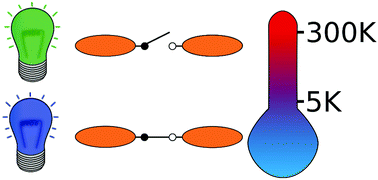Temperature dependence of the conversion efficiency of photochromic perylene bisimide dithienylcyclopentene triads embedded in a polymer
Abstract
Photochromic molecules that are covalently linked to a strong fluorophore combine the requirements of external control and strong fluorescence, which will become increasingly important for super-resolution microscopy techniques based on single molecules. However, given the bulky structure of such constructs, steric hindrance might affect their photoconversion efficiencies upon immobilising them for imaging purposes. In this study the efficiencies of the photochromic conversion processes of molecular triads that are embedded in a polymer have been studied as a function of temperature. The triads consist of two perylene bisimide dye molecules that are connected via a dithienylcyclopentene photochromic bridge that undergoes a cyclization/cycloreversion reaction upon appropriate illumination. It is found that photochromic switching remains active, even at 5 K, yet with reduced but finite efficiency for the cycloreversion reaction. This might even be an advantage for the achievement of high labelling densities in super-resolution microscopy.



 Please wait while we load your content...
Please wait while we load your content...